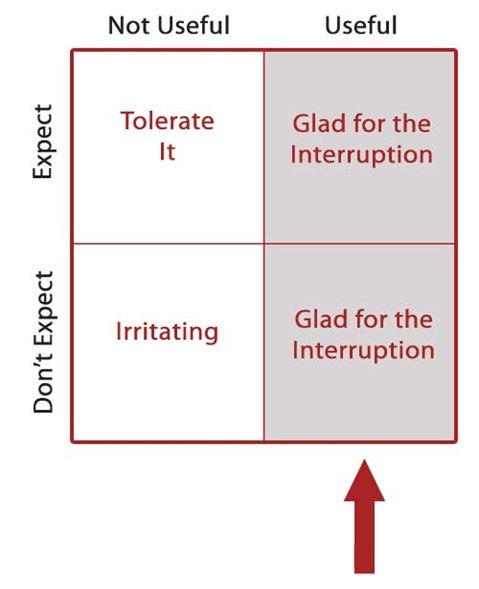Let’s say you’re working at your computer, reading this blog, and right now your iPhone rings. You answer, it’s your friend Paul. Paul says,
“Hey Buddy, I got my new flat panel over the weekend, 60 inch, and I am ready for football season! The picture is perfect, you can see it from every angle. The best thing is I got free installation of surround sound from Best Buy because I bought the combo package.”
Now you think to yourself:
“Free installation of surround sound? I was going to wait till Black Friday to get everything, but wouldn’t it be great to watch the Cowboys this season on 60 inches in surround sound?”
You just got interrupted…and you were glad you did.
But wait! Isn’t interruption a bad thing? If you listen to companies like Story Worldwide and other new media and social media prophets, “Interruption generates hostility.” Whatever. You keep your hostility, I’ll take the surround sound.
Interruption’s Bad Rap
The case against interruption is a fallacy conceived by a new generation of digital media / social media marketers. But it’s to be expected because they are selling against the traditional (interruption) media. Their argument is that we are in a new world of customer control. Where customers no longer want to be interrupted, and they must choose everything that comes their way. Where’s the logic in that?
To be sure, we are in a new era of customer control, but people are still people. Do they really only want to find out about things only by initiating their own search? Of course not. That’s way too much work. Sometimes people want products and information to come to them without going on a quest. People don’t mind being interrupted for good reason. In fact, the argument could be made that people are ok with interruption most of the time. Let’s take a look at why that is.
There are two types of interruption: those you like and those you don’t like. The kind you don’t like are interruptions that push something of which very few people have any interest, like detoxifying foot pads. Then there are the kind you do like, those that give you something useful. These interruptions alert you to information or products that you did not know about, but you wish you did. For example, I was once interrupted with the information about a tucked-away little pub that sells craft brews called The Dancing Bear. I’m now a regular.
Interruption happens at two different times: When you expect it and when you don’t expect it. Like when you are watching TV or listening to radio, or going to the movies, you expect to be interrupted with commercials or movie trailers. It’s part of the deal of getting entertainment and other stuff for free. The kind you don’t expect are those like the call from my friend Paul, or pop-up ads, or emails you didn’t ask for.
But even when you don’t expect interruption, or don’t ask for it, you might be ok with it. And as I hinted above, that’s probably most of the time. Let me illustrate with the nifty little graphic below I like to call the Interruption Matrix.
Even when interruptions are not useful, and people expect them, they’re still mostly ok with them. So really the only class of interruption that might cause hostility is the irritating ones people don’t expect (lower left corner). In fact, I should probably gray-out the top left box of the graphic to make my argument look more forceful.
I grow weary of advertising getting a bad rap and social media assuming the lofty, holier-than-thou position of non-interruption. Have you seen social media lately? Twitter streams are full of tweets people don’t ask for. In fact, there is more interruption in social media than there is in traditional media. But you expect it in traditional media. It’s part of the deal.
It seems pretty obvious that interruption is here to stay, and that’s mostly ok with the people getting interrupted. As long as they expect it, or they find it useful, they don’t mind getting interrupted. Interruption does not necessarily breed hostility. …by the way, did you know that I offer coaching and consulting services for entrepreneurs? :)
If you liked this article, please consider subscribing. For updates on new articles: Receive The Marketing Spot by Email or Get The Marketing Spot in a blog reader

